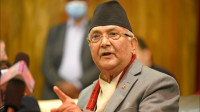National
With no end to the pandemic in sight and no roadmap for recovery, the tourism sector looks at a prolonged slump
Tourism entrepreneurs had high hopes from government but have so far been disappointed at the lack of a plan for sector..jpg&w=900&height=601)
Sangam Prasain
This year, in May, there were just 30 foreign arrivals to Nepal, a precipitous drop of more than 99.9 percent in tourist numbers when compared to the same month last year when there were over 70,000 arrivals. This May’s 30 foreign arrivals, too, were part of diplomatic missions, and not tourists.
The drop is the steepest on record since the 1960s, when Nepal began direct links to Indian cities and became more accessible to the outside world.
With the border closed and internal travel prohibited for more than two months now, the once-booming tourism sector in Nepal is on the verge of collapse, and it is not likely to recover any time soon, say industry insiders.
According to economists, the impact of the Covid-19 pandemic is likely to have a deeper and more far-reaching impact than natural disasters, including the 2015 earthquakes, as it is difficult to predict when the pandemic would be over and when tourists will feel safe enough to travel again.
“Unlike other business sectors, tourism will take a longer time to return to normalcy because tourists need an assurance that the situation is safe before they travel again,” said economist Dadhi Adhikari. “In the Nepali context, the government appears to be indifferent towards the private sector. It has no clear roadmap and no plans to help the tourism sector recover quickly after the pandemic.”
Although the government has yet to decide on a tentative timeline for opening up the country, many of the world’s most popular travel destinations are reopening to international travellers this summer.
The European Union has already announced that non-Europeans will be allowed to enter from July 1 and the Indonesian island of Bali is said to be reopening in October.
In South Asia, commercial airlines are scheduled to resume in the Maldives from July 1. Sri Lanka is preparing to reopen its borders to all nationalities on August 1, if individuals can produce proof of medical insurance, plan to stay at least five nights, and can show a negative Covid-19 test taken less than 72 hours before departure.
Nepal too should prepare a roadmap to reopen, said Yogendra Sakya, a hotelier. According to Sakya, the private sector had big expectations from the new budget, but ultimately, there was little to address the plight of the tourism industry.
“In the current context, I estimate a loss of Rs50 million in 2020,” said Sakya. “I can survive for a year but what about 2021 when there is no recovery plan? I cannot afford to lose another Rs50 million.”
Hoteliers like Sakya say that bankruptcy is “likely”, which will then deal a major blow to the country’s economy and employment. Nepal’s tourism sector generated Rs240.7 billion in revenue and supported more than 1.05 million jobs directly and indirectly in 2018, according to a World Travel and Tourism Council research report. According to the London-based organisation, travel and tourism's total contribution to the country’s gross domestic product stood at 7.9 percent in the previous year.
The World Tourism Organisation (UNWTO) said that for least developed countries like Nepal that are highly dependent on tourism, Covid-19’s impacts on health and livelihoods will be perhaps exponential.
Tourism’s recovery will not depend exclusively on lifting Covid-19-imposed travel bans; the sector will recover once communities where people live become safe, which warrants the inclusion of tourism in national and global recovery packages to support the healthcare system, say insiders.
“We had expected that the budget would focus on the recovery of the tourism industry but all the government announced was a travel concession for its employees from the next fiscal year in order to revive the domestic tourism industry,” said tourism entrepreneur Ashok Pokharel. “How can people who have been laid off, sent on unpaid leave or had their salaries cut promote domestic tourism? This is an unrealistic plan.”
According to the UNWTO, in 2020, global international tourist arrivals could decline by 20 to 30 percent, from an estimated growth forecast of 3 to 4 percent in January 2020. This means a loss of $30-50 billion in spending by international visitors.
“Understandably, LDC capacity to deal with a pandemic of this scale is modest; therefore, the road to recovery will be longer and more difficult, especially because these economies have a large percentage of poor,” said the UNWTO.
Nepal on March 20 banned all passengers, including Nepalis, from entering the country from European Union territories, including the United Kingdom, West Asia, Gulf countries and countries like Iran, Turkey, Malaysia, South Korea and Japan. On March 24, it imposed a complete lockdown.
With no end to the global pandemic in sight, Pokharel believes that Nepal’s tourism sector is set for a prolonged slump, affecting revenue across and rendering thousands of people jobless.
“As the government’s plans are made without consultation with experts and economists, all sectors are in trouble. As a result, thousands are taking to the streets protesting the inefficiency of the government to deal with the pandemic,” said economist Adhikari.
Before the pandemic spread, the country was promoting itself domestically and internationally with the Visit Nepal 2020 campaign. But the pandemic put a halt to all travel plans and now, the once-packed trekking routes have more monkeys than tourists.




 5.39°C Kathmandu
5.39°C Kathmandu










%20(1).jpg&w=300&height=200)



